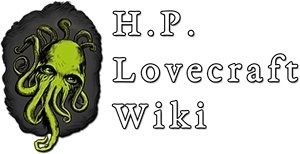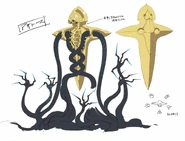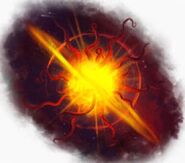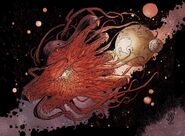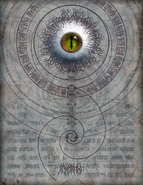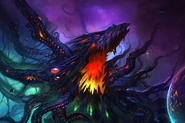No edit summary |
|||
| (40 intermediate revisions by 16 users not shown) | |||
| Line 1: | Line 1: | ||
| + | {{alt|''This is an article about the character. For the story fragment, see "[[Azathoth (short story)]]"''}} |
||
| − | {{Inmythos}} |
||
{{Infobox character |
{{Infobox character |
||
| ⚫ | |||
| − | |name = Azathoth |
||
| ⚫ | |||
| ⚫ | |||
| ⚫ | |||
*Nuclear Chaos |
*Nuclear Chaos |
||
*Daemon Sultan |
*Daemon Sultan |
||
*Abyssal Idiot |
*Abyssal Idiot |
||
| + | *Lord of All |
||
| − | *Crawling Chaos |
||
| + | *Achamoth |
||
| ⚫ | |||
| + | *Vach-Viraj |
||
| − | |died = Cannot possibly die. |
||
| ⚫ | |||
| ⚫ | |||
| + | |died = Immortal |
||
| − | |powers = Reality warping and Omnipresence |
||
| ⚫ | |||
| ⚫ | |||
| + | |powers = [[w:c:powerlisting:Reality warping|Reality warping]], [[w:c:powerlisting:Omnipresence|Omnipresence]], [[w:c:powerlisting:Metapotence|Metapotence]], and [[w:c:powerlisting:Omninescience|Omninescience]] |
||
| ⚫ | |||
| ⚫ | |||
| − | *[[Bärkatlànm]] (Son) |
||
| ⚫ | |||
*The [[Darkness]] (offspring) |
*The [[Darkness]] (offspring) |
||
*[[The Nameless Mist]] (offspring) |
*[[The Nameless Mist]] (offspring) |
||
| Line 23: | Line 23: | ||
*[[Cthulhu]] (Great-Great-Grandson) |
*[[Cthulhu]] (Great-Great-Grandson) |
||
*[[Tsathoggua]] (Great-Great-Grandson) |
*[[Tsathoggua]] (Great-Great-Grandson) |
||
| − | |spouse |
+ | |spouse = N/A <small>(reproduced by fission)</small> |
|affiliations = [[Outer God]]s |
|affiliations = [[Outer God]]s |
||
| − | |species |
+ | |species = [[Outer God]] |
| − | |first |
+ | |first = {{HPL}}: "[[The Dream-Quest of Unknown Kadath]]" |
| + | |appearances = *{{HPL}}: "[[The Dream-Quest of Unknown Kadath]]" |
||
| ⚫ | |||
| + | *{{HPL}}: "[[The Dreams in the Witch House]]" |
||
| ⚫ | {{quote|[O]utside the ordered universe [is] that amorphous blight of nethermost confusion which blasphemes and bubbles at the center of all infinity—the boundless daemon sultan Azathoth, whose name no lips dare speak aloud, and who gnaws hungrily in inconceivable, unlighted chambers beyond time and space amidst the muffled, maddening beating of vile drums and the thin monotonous whine of accursed flutes.| |
||
| + | *{{HPL}}: "[[The Thing on the Doorstep]]" |
||
| + | *{{HPL}}: "[[The Haunter of the Dark]]" |
||
| + | *{{HPL}}: "[[Lurker on the Threshold]]" |
||
| ⚫ | |||
| ⚫ | |||
| ⚫ | |||
| + | }} |
||
| ⚫ | {{quote|[O]utside the ordered universe [is] that amorphous blight of nethermost confusion which blasphemes and bubbles at the center of all infinity—the boundless daemon sultan Azathoth, whose name no lips dare speak aloud, and who gnaws hungrily in inconceivable, unlighted chambers beyond time and space amidst the muffled, maddening beating of vile drums and the thin monotonous whine of accursed flutes.|{{HPL}}|[[The Dream-Quest of Unknown Kadath]]}} |
||
| + | {{Lovecraftcircle}} {{ImageLink}} |
||
'''Azathoth''', sometimes called "'''The Blind Idiot God'''", the "'''Nuclear Chaos'''", the "'''Daemon Sultan'''", "The Deep Dark", and "The Cold One", is an [[Outer God]]. |
'''Azathoth''', sometimes called "'''The Blind Idiot God'''", the "'''Nuclear Chaos'''", the "'''Daemon Sultan'''", "The Deep Dark", and "The Cold One", is an [[Outer God]]. |
||
==Description== |
==Description== |
||
| − | There can be no definite description of Azathoth because everybody envisions him differently and he is always changing. |
+ | There can be no definite description of Azathoth because everybody envisions him differently and he is always changing. There is evidence the physical manifestation of Azathoth in the universe is continuous with a spot in the central region of the galaxy, otherwise known as Sagittarius A* - the supermassive black hole at the center of the Milky Way galaxy. |
| ⚫ | For example Ronald Shea enters a temple after visiting the forest near Goatswood and discovers a twenty-foot idol that "represented the god Azathoth--Azathoth as he had been before his exile Outside...[I]t consisted of a bivalvular shell supported on many pairs of flexible legs. From the half-open shell rose several jointed cylinders, tipped with polypous appendages; and in the darkness inside the shell I thought I saw a horrible bestial, mouthless face, with deep-sunk eyes and covered with glistening black hair." |
||
| ⚫ | |||
| ⚫ | |||
| ⚫ | |||
| ⚫ | Another note Lovecraft made to himself later in 1919 refers to an idea for a story: "A terrible pilgrimage to seek the nighted throne of the far daemon-sultan Azathoth." |
||
| + | ==In the Necronomicon== |
||
| ⚫ | Price sees another inspiration for Azathoth in [[Lord Dunsany]]'s Mana-Yood-Sushai, from The Gods of Pegana, a creator deity "who made the gods and thereafter rested." In Dunsany's conception, MANA-YOOD-SUSHAI sleeps eternally, lulled by the music of a lesser deity who must drum forever, "for if he cease for an instant then [[Mana-Yood-Sushai|MANA-YOOD-SUSHAI]] will start awake, and there will be worlds nor gods no more." This oblivious creator god accompanied by supernatural musicians is a clear prototype for Azathoth, Price argues. |
||
| + | Azathoth is a significant malign presence In the [[Necronomicon]] as both Albert Wilmarth ({{HPL}}: "[[The Whisperer in Darkness]]") and Walter Gilman ({{HPL}}: "[[The Dreams in the Witch House]]") are horrified at the mere mention of it's name having both read about it in the occult tome. |
||
| ⚫ | In Gilman's case it's the witch Keziah Mason who references Azathoth while haunting his dreams telling him "He must meet [[The Black Man]], and go with them all to the throne of Azathoth at the centre of ultimate Chaos.... He must sign in his own blood the book of Azathoth and take a new secret name.... What kept him from going with her...to the throne of Chaos where the thin flutes pipe mindlessly was the fact that he had seen the name 'Azathoth' in the Necronomicon, and knew it stood for a primal horror too horrible for description." |
||
| − | ==Fiction== |
||
| − | ===Works by Lovecraft=== |
||
| − | Aside from the title of the novel fragment, "[[The Dream-Quest of Unknown Kadath]]" was the first fiction by Lovecraft to mention Azathoth.<ref>H. P. Lovecraft, ''The Dream-Quest of Unknown Kadath'', in ''At The Mountains of Madness'', p. 308.</ref> |
||
| + | It is also portrayed as a leader in a cosmic upheaval akin to Lucifer's rebellion in the Bible and is prophesied to return |
||
| − | Lovecraft referred to Azathoth again in "[[The Whisperer in Darkness]]" (1931), where the narrator relates that he "started with loathing when told of the monstrous nuclear chaos beyond angled space which the [[Necronomicon]] had mercifully cloaked under the name of Azathoth". |
||
| ⚫ | {{quote|(T)hose daring to oppose the Elder Gods who ruled from Betelgueze, the Great Old Ones who fought against the Elder Gods...were instructed by Azathoth, who is the blind idiot god, and by Yog-Sothoth ... (Y)e blind idiot, ye noxious Azathoth shal arise from ye middle of ye World where all is Chaos & Destruction where He hath bubbl'd and blasphem'd at Ye centre which is of All Things, which is to say Infinity....|{{AWD}}|[[Lurker on the Threshold]]}} |
||
| ⚫ | In |
||
| + | ==In the Mythos== |
||
| − | Gilman wakes from another dream remembering "the thin, monotonous piping of an unseen flute", and decides that "he had picked up that last conception from what he had read in the Necronomicon about the mindless entity Azathoth, which rules all time and space from a curiously environed black throne at the centre of Chaos."He later fears finding himself in the spiral black vortices of that ultimate void of Chaos wherein reigns the mindless daemon-sultan Azathoth". |
+ | Gilman wakes from another dream remembering "the thin, monotonous piping of an unseen flute", and decides that "he had picked up that last conception from what he had read in the Necronomicon about the mindless entity Azathoth, which rules all time and space from a curiously environed black throne at the centre of Chaos."He later fears finding himself in the spiral black vortices of that ultimate void of Chaos wherein reigns the mindless daemon-sultan Azathoth" ({{HPL}}: "The Dreams in the Witch House"). |
| − | The poet Edward Pickman Derby |
+ | The poet Edward Pickman Derby wrote a collection of "nightmare lyrics" is called "Azathoth and Other Horrors." ({{HPL}}: [[The Thing on the Doorstep]]). |
| − | + | {{quote|... ancient legends of Ultimate Chaos, at whose center sprawls the blind idiot god Azathoth, Lord of All Things, encircled by his flopping horde of mindless and amorphous dancers, and lulled by the thin monotonous piping of a demoniac flute held in nameless paws.|{{HPL}}|"[[The Haunter of the Dark]]"}} |
|
| + | ==Worshipers== |
||
| − | ===Works by Other writers=== |
||
| ⚫ | Among his many followers the worshippers in the town of Goatswood that practice "obscene rites" that involved "atrocities practiced on still-living victims" in Azathoth's conical temple are insects that have fled the destruction of their home planet of Shaggai, bringing the temple across the universe with them ({{EXP}}: "[[The Insects from Shaggai]]", [[Ramsey Campbell]]). |
||
| − | ====August Derleth==== |
||
| − | Many other Mythos writers have referred to Azathoth in their stories. August Derleth, in his novel The Lurker on the Threshold, depicts the entity as a leader in a cosmic upheaval akin to Lucifer's rebellion in the Bible. In a passage attributed to the Necronomicon of Abdul Alhazred, Derleth writes: |
||
| + | ==Behind the Mythos== |
||
| − | "(T)hose daring to oppose the Elder Gods who ruled from Betelgueze, the Great Old Ones who fought against the Elder Gods...were instructed by Azathoth, who is the blind idiot god, and by Yog-Sothoth...." |
||
| + | * George Olshevsky named the nonconvex snub polyhedra after some other Great Old Ones, with the Great retrosnub icosidodecahedron as "Azathoth". |
||
| + | *Trey Azagthoth (George Michel Emmanuel III), lead guitarist of American death metal band Morbid Angel, named himself after the Ancient One and altered the spelling. |
||
| ⚫ | *Thomas Ligotti has stated that many of his short stories make allusions to Lovecraft's Azathoth, although rarely by that name. A classic example of this is the story "Nethescurial", which portrays an omnipresent, malevolent creator deity once worshipped by the inhabitants of a small island. This being slowly infiltrates the life of the story's narrator, first via a manuscript describing its cult. |
||
| ⚫ | |||
| − | In another passage, Derleth quotes a prophecy: |
||
| + | *The first recorded mention of Azathoth was in a note Lovecraft wrote to himself in 1919 that read simply, "AZATHOTH—hideous name." ({{HPL}}: "[[Commonplace Book]] #44) |
||
| − | |||
| ⚫ | * Mythos editor [[Robert M. Price]] argues that Lovecraft could have combined the biblical names Anathoth (Jeremiah's home town) and Azazel (a desert demon to which the scapegoat was sacrificed - mentioned by Lovecraft in "[[The Dunwich Horror]]"). Price also points to the alchemical term "Azoth", which was used in the title of a book by [[Arthur Edward Waite]], the model for the wizard Ephraim Waite in Lovecraft's "[[The Thing on the Doorstep]]". Other possible inspirations include the name Thoth, the ancient Egyptian god of wisdom. |
||
| ⚫ | |||
| ⚫ | *Another note Lovecraft made to himself later in 1919 refers to an idea for a story: "A terrible pilgrimage to seek the nighted throne of the far daemon-sultan Azathoth." ({{HPL}}: ''[[Commonplace Book]]'' #61) Lovecraft ties this "[[Azathoth (short story)|Azathoth]]" plot germ to [[Vathek]], a novel by [[William Beckford]] about a supernatural caliph, ({{HPL}}: ''[[Selected Letters]]'' 1.104) but his attempts to work this idea into a novel floundered, leaving only a 500-word fragment posthumously published, although Lovecraftian scholar Will Murray suggests that Lovecraft recycled the idea into ''[[The Dream-Quest of Unknown Kadath]]''. |
||
| − | |||
| ⚫ | *Price sees another inspiration for Azathoth in [[Lord Dunsany]]'s Mana-Yood-Sushai, from {{ADJ}}: ''[[The Gods of Pegana]]'', a creator deity "who made the gods and thereafter rested." In Dunsany's conception, MANA-YOOD-SUSHAI sleeps eternally, lulled by the music of a lesser deity who must drum forever, "for if he cease for an instant then [[Mana-Yood-Sushai|MANA-YOOD-SUSHAI]] will start awake, and there will be worlds nor gods no more." This oblivious creator god accompanied by supernatural musicians is a clear prototype for Azathoth, Price argues. |
||
| − | ====Ramsey Campbell==== |
||
| ⚫ | |||
| − | |||
| − | Ronald Shea, the narrator of Campbell's story, enters the temple after visiting the forest and discovers a twenty-foot idol that "represented the god Azathoth--Azathoth as he had been before his exile Outside": |
||
| − | |||
| ⚫ | |||
| − | |||
| − | At the story's climax, Shea catches a glimpse of "what the idiot god might now resemble": |
||
| − | |||
| ⚫ | |||
| − | |||
| − | ====Thomas Ligotti==== |
||
| − | Thomas Ligotti's short story "The Sect of the Idiot" (1988) mentions a circle of non-human worshippers composed of wizened, hideous creatures. The story's epigram--a "quotation" from the Necronomicon--reads "The primal chaos, Lord of all...the blind idiot god--Azathoth," suggesting that it is that entity whom the creatures worship. |
||
| − | |||
| ⚫ | Ligotti has stated that many of his short stories make allusions to Lovecraft's Azathoth, although rarely by that name. A classic example of this is the story "Nethescurial", which portrays an omnipresent, malevolent creator deity once worshipped by the inhabitants of a small island. This being slowly infiltrates the life of the story's narrator, first via a manuscript describing its cult. |
||
| − | |||
| − | ====Nick Mamatas==== |
||
| − | Nick Mamatas's 2004 novel Move Under Ground, set in a world where Cthulhu has taken power and only the Beats oppose him, the power of the Great Old Ones twists the constellations into new shapes, using them as vessels for his surrogates; among them, Jack Kerouac observes the "red stars of Azathoth" among them. Neal Cassady later becomes a chosen one of Azathoth, gaining immense powers to be used against Cthulhu in the process. |
||
| − | |||
| − | ==== Sara Bardi ==== |
||
| − | In Sara Bardi's webcomic Lovely Lovecraft, Azathoth is trapped in the form of a human female with purple hair and eyes that doesn't match. At the start of the story, she is held in an insane asylum on account of her inability to say anything beyond mad ramblings seemingly without meaning. She seems unaware that she is trapped in a lesser form, or simply doesn't care. She is later broken out by a Shoggoth controlled by Nyarlathotep. |
||
| − | |||
| ⚫ | |||
| − | In 1995, Chaosium published The Azathoth Cycle, a Cthulhu Mythos anthology focusing on works referring to or inspired by the entity Azathoth. Edited by Lovecraft scholar Robert M. Price, the book includes an introduction by Price tracing the roots and development of the Blind Idiot God. The contents include: |
||
| − | * "Azathoth (Derby)" by Edward Pickman Derby |
||
| − | * "Azathoth in Arkham" by [[Peter Cannon]] |
||
| − | * "The Revenge of Azathoth" by Peter Cannon |
||
| − | * "The Pit of the Shoggoths" by Stephen M. Rainey |
||
| − | * "[[Hydra]]" by Henry Kuttner |
||
| − | * "The Madness Out of Time" by Lin Carter |
||
| ⚫ | |||
| − | * "The Sect of the Idiot" by Thomas Ligotti |
||
| − | * "The Throne of Achamoth" by [[Richard L. Tierney]] & Robert M. Price |
||
| − | * "The Last Night of the Earth" by [[Gary Myers]] |
||
| − | * "The Daemon-Sultan" by Donald R. Burleson |
||
| − | * "Idiot Savant" by C. J. Henderson |
||
| − | * "The Space of Madness" by Stephen Studach |
||
| − | * "The Nameless Tower" by [[John Glasby]] |
||
| − | * "The Plague Jar" by Allen Mackey |
||
| − | * "The Old Ones’ Promise of Eternal Life" by Robert M. Price |
||
==See also== |
==See also== |
||
| Line 111: | Line 82: | ||
==Gallery== |
==Gallery== |
||
<gallery> |
<gallery> |
||
| + | Azathoth_Concept_Art.png|Azathoth(Persona 5 Royal) |
||
| − | Screenshot 20171212-092251.jpg |
||
Azathoth.jpg |
Azathoth.jpg |
||
| + | Azathoth_2_(Edition_Sans-Detour).jpg|Azathoth (Call of Cthulhu, French version) |
||
| + | --Azathoth--.jpg|Azathoth (Cthulhu Wars) |
||
| + | Azathoth_(Petersen_Games).jpg|Azathoth (Cthulhu Wars) |
||
| + | Azathoth_(Editions_Sans-Detour).jpg|Azathoth (Call of Cthulhu, French version) |
||
| + | Azathoth_(Fantasy_Flight_Games).jpg|Azathoth (Fantasy Flight Games) |
||
| + | Azathoth_(Paizo_Inc).jpg|Azathoth (Pathfinder) |
||
Azathoth (1).jpg |
Azathoth (1).jpg |
||
| + | Azathoth_(Rise_of_Cthulhu).jpg|Azathoth (Rise of Cthulhu) |
||
| − | --Azathoth--.jpg |
||
Russell Logo.png |
Russell Logo.png |
||
| + | Azathoth_(Avatar_Press).jpg|Azathoth (Providence) |
||
Azathoth_Russell.png|Azathoth, as it appears in Russell's Guide (merzo.net) |
Azathoth_Russell.png|Azathoth, as it appears in Russell's Guide (merzo.net) |
||
AZATHOTH.jpg |
AZATHOTH.jpg |
||
Screenshot_20171020-130928.jpg |
Screenshot_20171020-130928.jpg |
||
| + | Azathoth by bergamind-d61fuwh.jpg |
||
</gallery> |
</gallery> |
||
| + | [[de:{{PAGENAME}}]] |
||
| − | |||
| + | [[es:{{PAGENAME}}]] |
||
| − | ==References== |
||
| − | {{Reflist}}{{DEFAULTSORT:Azathoth}} |
||
[[Category:Characters]] |
[[Category:Characters]] |
||
[[Category:Outer Gods]] |
[[Category:Outer Gods]] |
||
| + | [[Category:Doctor Who (Cthulhu Mythos)]] |
||
| + | [[Category:Pathfinder (Cthulhu Mythos)]] |
||
| + | [[Category:Hyborian (Cthulhu Mythos)]] |
||
Revision as of 21:11, 20 May 2020
- 🔀 This is an article about the character. For the story fragment, see "Azathoth (short story)"
| “ | [O]utside the ordered universe [is] that amorphous blight of nethermost confusion which blasphemes and bubbles at the center of all infinity—the boundless daemon sultan Azathoth, whose name no lips dare speak aloud, and who gnaws hungrily in inconceivable, unlighted chambers beyond time and space amidst the muffled, maddening beating of vile drums and the thin monotonous whine of accursed flutes. | „ | |
| ~ HPL , The Dream-Quest of Unknown Kadath |
![]() 🎨
Azathoth, sometimes called "The Blind Idiot God", the "Nuclear Chaos", the "Daemon Sultan", "The Deep Dark", and "The Cold One", is an Outer God.
🎨
Azathoth, sometimes called "The Blind Idiot God", the "Nuclear Chaos", the "Daemon Sultan", "The Deep Dark", and "The Cold One", is an Outer God.
Description
There can be no definite description of Azathoth because everybody envisions him differently and he is always changing. There is evidence the physical manifestation of Azathoth in the universe is continuous with a spot in the central region of the galaxy, otherwise known as Sagittarius A* - the supermassive black hole at the center of the Milky Way galaxy.
For example Ronald Shea enters a temple after visiting the forest near Goatswood and discovers a twenty-foot idol that "represented the god Azathoth--Azathoth as he had been before his exile Outside...[I]t consisted of a bivalvular shell supported on many pairs of flexible legs. From the half-open shell rose several jointed cylinders, tipped with polypous appendages; and in the darkness inside the shell I thought I saw a horrible bestial, mouthless face, with deep-sunk eyes and covered with glistening black hair."
Later Shae sees "something ooze into the corridor--a pale grey shape, expanding and crinkling, which glistened and shook gelatinously as still-moving particles dropped free; but it was only a glimpse" (EXP: "The Insects from Shaggai", Ramsey Campbell).
In the Necronomicon
Azathoth is a significant malign presence In the Necronomicon as both Albert Wilmarth (HPL: "The Whisperer in Darkness") and Walter Gilman (HPL: "The Dreams in the Witch House") are horrified at the mere mention of it's name having both read about it in the occult tome.
In Gilman's case it's the witch Keziah Mason who references Azathoth while haunting his dreams telling him "He must meet The Black Man, and go with them all to the throne of Azathoth at the centre of ultimate Chaos.... He must sign in his own blood the book of Azathoth and take a new secret name.... What kept him from going with her...to the throne of Chaos where the thin flutes pipe mindlessly was the fact that he had seen the name 'Azathoth' in the Necronomicon, and knew it stood for a primal horror too horrible for description."
It is also portrayed as a leader in a cosmic upheaval akin to Lucifer's rebellion in the Bible and is prophesied to return
| “ | (T)hose daring to oppose the Elder Gods who ruled from Betelgueze, the Great Old Ones who fought against the Elder Gods...were instructed by Azathoth, who is the blind idiot god, and by Yog-Sothoth ... (Y)e blind idiot, ye noxious Azathoth shal arise from ye middle of ye World where all is Chaos & Destruction where He hath bubbl'd and blasphem'd at Ye centre which is of All Things, which is to say Infinity.... | „ | |
| ~ AWD , Lurker on the Threshold |
In the Mythos
Gilman wakes from another dream remembering "the thin, monotonous piping of an unseen flute", and decides that "he had picked up that last conception from what he had read in the Necronomicon about the mindless entity Azathoth, which rules all time and space from a curiously environed black throne at the centre of Chaos."He later fears finding himself in the spiral black vortices of that ultimate void of Chaos wherein reigns the mindless daemon-sultan Azathoth" (HPL: "The Dreams in the Witch House").
The poet Edward Pickman Derby wrote a collection of "nightmare lyrics" is called "Azathoth and Other Horrors." (HPL: The Thing on the Doorstep).
| “ | ... ancient legends of Ultimate Chaos, at whose center sprawls the blind idiot god Azathoth, Lord of All Things, encircled by his flopping horde of mindless and amorphous dancers, and lulled by the thin monotonous piping of a demoniac flute held in nameless paws. | „ | |
| ~ HPL , "The Haunter of the Dark" |
Worshipers
Among his many followers the worshippers in the town of Goatswood that practice "obscene rites" that involved "atrocities practiced on still-living victims" in Azathoth's conical temple are insects that have fled the destruction of their home planet of Shaggai, bringing the temple across the universe with them (EXP: "The Insects from Shaggai", Ramsey Campbell).
Behind the Mythos
- George Olshevsky named the nonconvex snub polyhedra after some other Great Old Ones, with the Great retrosnub icosidodecahedron as "Azathoth".
- Trey Azagthoth (George Michel Emmanuel III), lead guitarist of American death metal band Morbid Angel, named himself after the Ancient One and altered the spelling.
- Thomas Ligotti has stated that many of his short stories make allusions to Lovecraft's Azathoth, although rarely by that name. A classic example of this is the story "Nethescurial", which portrays an omnipresent, malevolent creator deity once worshipped by the inhabitants of a small island. This being slowly infiltrates the life of the story's narrator, first via a manuscript describing its cult.
Inspiration
- The first recorded mention of Azathoth was in a note Lovecraft wrote to himself in 1919 that read simply, "AZATHOTH—hideous name." (HPL: "Commonplace Book #44)
- Mythos editor Robert M. Price argues that Lovecraft could have combined the biblical names Anathoth (Jeremiah's home town) and Azazel (a desert demon to which the scapegoat was sacrificed - mentioned by Lovecraft in "The Dunwich Horror"). Price also points to the alchemical term "Azoth", which was used in the title of a book by Arthur Edward Waite, the model for the wizard Ephraim Waite in Lovecraft's "The Thing on the Doorstep". Other possible inspirations include the name Thoth, the ancient Egyptian god of wisdom.
- Another note Lovecraft made to himself later in 1919 refers to an idea for a story: "A terrible pilgrimage to seek the nighted throne of the far daemon-sultan Azathoth." (HPL: Commonplace Book #61) Lovecraft ties this "Azathoth" plot germ to Vathek, a novel by William Beckford about a supernatural caliph, (HPL: Selected Letters 1.104) but his attempts to work this idea into a novel floundered, leaving only a 500-word fragment posthumously published, although Lovecraftian scholar Will Murray suggests that Lovecraft recycled the idea into The Dream-Quest of Unknown Kadath.
- Price sees another inspiration for Azathoth in Lord Dunsany's Mana-Yood-Sushai, from ADJ: The Gods of Pegana, a creator deity "who made the gods and thereafter rested." In Dunsany's conception, MANA-YOOD-SUSHAI sleeps eternally, lulled by the music of a lesser deity who must drum forever, "for if he cease for an instant then MANA-YOOD-SUSHAI will start awake, and there will be worlds nor gods no more." This oblivious creator god accompanied by supernatural musicians is a clear prototype for Azathoth, Price argues.
